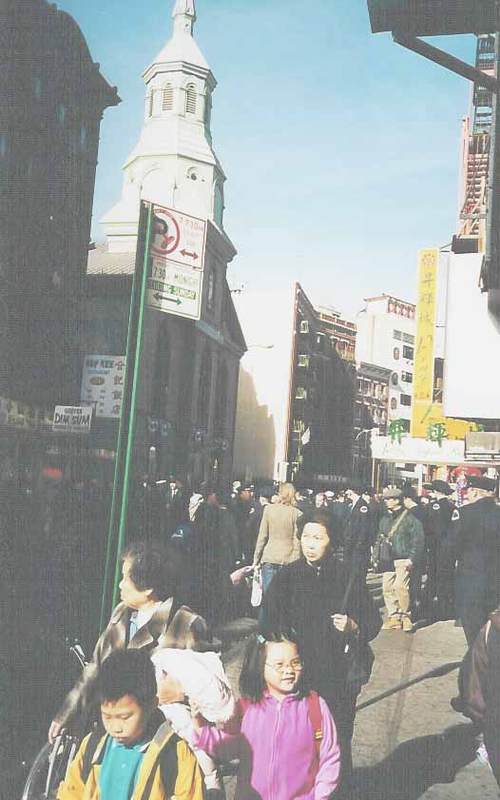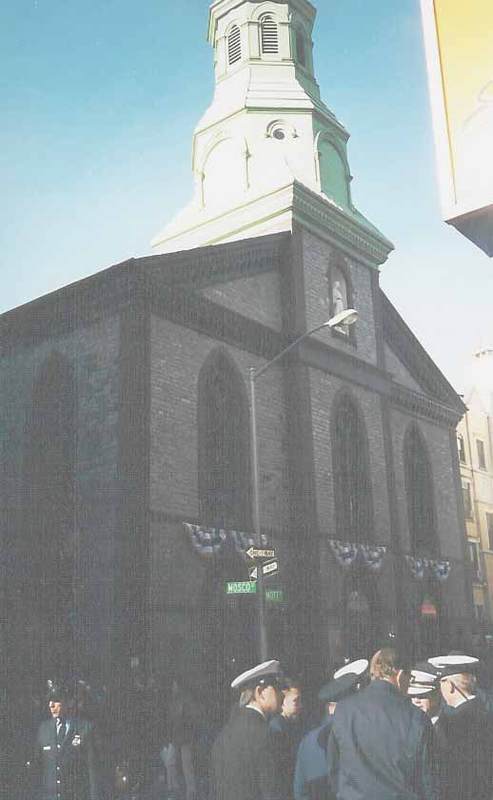Transfiguration Church
Church of Immigrants
Transfiguration parish in Chinatown celebrates 175 years
By Mary Ann Poust
The Pastor of Transfiguration parish in Manhattan's Chinatown is a Maryknoll priest who spent 15 years as a missioner in Hong Kong. But his 12 years at Transfiguration have been "as much of a mission experience to me as any I've seen in the world", said Father Raymond J. Nobiletti, M.M.
Transfiguration, celebrating its 175th anniversary, welcomes waves of new immigrants from China each year, adding to an already settled Chinese immigrant population and their American-born children
It's a parish with many poor people, a parish of outreach and a parish of evangelization, with 40 to 50 adults learning about and joining the Church every year.
'There have always been waves of immigrants coming to this parish," Father Nobiletti said. "First it was the Irish, then the Italians and now the Chinese. We're known as the Church of Immigrants."
Some 900 people attend the four Sunday Masses -- one each in Mandarin and Cantonese Chinese and two in English -- with most making a special trip to the church at 29 Mott St. from their homes elsewhere in the city or the suburbs for the Chinese Masses.
Father Nobiletti, who speaks Cantonese -- usually celebrates the Cantonese Mass. Visiting priests celebrate in Mandarin.
On Oct. 27, Cardinal Egan visited Transfiguration to celebrate the 1 p.m. Mass in honor of the anniversary. He blessed the church's newly rebuild and refurbished pipe organ, dedicated to those who died Sept. 11, 2001, and he dedicated a statue of Cuban-born Father Felix Varela, founder of the parish. The bronze statue, to be mounted on the wall between the church and parish school, was donated by he U. S. Cuban community and the Father Felix Varela Foundation.
Father Varela, who advocated Cuban independence from Spain, settled in lower Manhattan when he was forbidden to return to his native country by the Spanish government.
From a base in St. Peter's Church on Barclay Street, he started Transfiguration parish in 1827 to minister to the poor Irish immigrants flooding into what was becoming a teeming crime- and gang-ridden slum district. A school was established in 1832.
Father Varela remained the pastor for 23 years, becoming an ardent advocate for the poor, for education and for social reform, and serving simultaneously as archdiocesan vicar general.
In 1853, the archdiocese bought a church building that had housed first a Lutheran and then an Episcopal congregation, and Transfiguration Church was moved there -- remaining in the same building to the present day.
The school, which had several homes in the area around what is now City Hall, moved to a building adjacent to the new church which was hastily renovated to accommodate the 1,000 children who were enrolled in the years just before the Civil War.
By the turn of the century, the great wave of immigration into the U.S. had begun to change the ethnic makeup of the neighborhood, and Italian, Jewish and Eastern European immigrants came to dominate lower Manhattan.
The parish community became predominantly Italian, and the area known as Little Italy. In 1922, ground was broken for a new school by Cardinal Patrick Hayes, who was himself an alumnus of Transfiguration School.
The neighborhood underwent another change following World War II, as Chinese immigration picked up substantially and the children of the older Europeans began moving to the suburbs.
Today, the school is operating at capacity with 280 children in the main building in grades one to eight, and 125 in a kindergarten in rented apace nearby. Both have waiting lists. ...
A Chinese school on weekends, ... which teaches the Chinese language and culture to Chinese-American children, has an enrollment of 900 students who attend classes held on Saturdays and Sundays in the school and kindergarten buildings and in St. James School a short distance away.
"I beefed that up because education is a very important value for the Chinese," Father Nobiletti said. he added that one reason the parish elementary school is so popular is that Chinese parents, even those with no religious training themselves, want their children to learn moral values.
The parish also has a religious education program which served 85 children under the direction of Sister Mary Ann Scherer, C.S.A.
There are 15 parish groups, including a Cantonese Chinese Society and a Mandarin Chinese Society.
For the anniversary celebration in mid-October, the parish re-established its St. Vincent de Paul Society, which was first started in 1857 then died out in the 1950s. Father Nobiletti was scheduling meetings with the members to plan its ministry -- but it will follow the mission of serving the needy.
"Every parish has its poor," he said.
Reference: Catholic New York, November 2002 pp 20-21,
Marist College | Marist Archives & Special Collections | Contact Us | Acknowledgements

